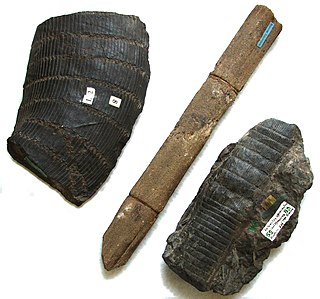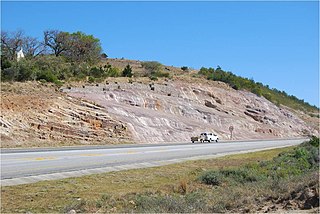
Calamites is a genus of extinct arborescent (tree-like) horsetails to which the modern horsetails are closely related. Unlike their herbaceous modern cousins, these plants were medium-sized trees, growing to heights of 30-50 meters. They were components of the understories of coal swamps of the Carboniferous Period.

Equisetidae is one of the four subclasses of Polypodiopsida (ferns), a group of vascular plants with a fossil record going back to the Devonian. They are commonly known as horsetails. They typically grow in wet areas, with whorls of needle-like branches radiating at regular intervals from a single vertical stem.

Groenlandaspis is an extinct genus of arthrodire from the Late Devonian. Fossils of the different species are found in late Devonian strata in all continents except eastern Asia. The generic name commemorates the fact that the first specimens of the type species (G.mirabilis) were found in Greenland.

Psilophyton is a genus of extinct vascular plants. Described in 1859, it was one of the first fossil plants to be found which was of Devonian age. Specimens have been found in northern Maine, USA; Gaspé Bay, Quebec and New Brunswick, Canada; the Czech Republic; and Yunnan, China. Plants lacked leaves or true roots; spore-forming organs or sporangia were borne on the ends of branched clusters. It is significantly more complex than some other plants of comparable age and is thought to be part of the group from within which the modern ferns and seed plants evolved.

Ephedra aspera is a species of Ephedra known by the common names rough jointfir, boundary ephedra, and pitamoreal. It is native to the southwestern United States from California to Texas and parts of northern Mexico as far south as Zacatecas. It is a resident of varied woodland and scrub plant communities.
Sphenophyllales is an extinct order of articulate land plants and a sister group to the present-day Equisetales (horsetails). They are fossils dating from the Devonian to the Triassic. They were common during the Late Pennsylvanian to Early Permian, with most of the fossils coming from the Carboniferous period.
Renalia is a genus of extinct vascular plants from the Early Devonian. It was first described in 1976 from compressed fossils in the Battery Point Formation. It is difficult to reconstruct the original form of the complete plant, but it appears to have consisted of leafless branching stems whose side branches had sporangia at their tips. It is regarded as an early relative of the lycophytes.
Hicklingia is a genus of extinct plants of the Middle Devonian. Compressed specimens were first described in 1923 from the Old Red Sandstone of Scotland. Initially the genus was placed in the "rhyniophytes", but this group is defined as having terminal sporangia, and later work showed that the sporangia of Hicklingia were lateral rather than strictly terminal, so that it is now regarded as having affinities with the zosterophylls.
Discalis is a genus of extinct vascular plants of the Early Devonian. The name is derived from the Greek δίσκος, referring to the disc-shaped sporangia. The genus was first described by Hao in 1989 based on fossil specimens from the Posongchong Formation, Wenshan district, Yunnan, China.
Distichophytum is a genus of extinct vascular plants of the Late Silurian (Ludfordian) to Early Devonian (Emsian), around 426 to 393 million years ago. The genus has a tangled taxonomic history, also being known as Bucheria and Rebuchia.
Rotafolia songziensis is a species of the extinct Sphenophyllales horsetails.

The Waterloo Farm lagerstätte is a Famennian lagerstätte in South Africa that constitutes the only known record of a near-polar Devonian coastal ecosystem.
Eleocharis confervoides is a species of plant in the sedge family (Cyperaceae). It is a perennial, submerged, aquatic and deeply rooted herb. It is known by its common name Algal bulrush and has lots of synonyms. The species has worldwide but very spotty distribution and is native in many tropical and subtropical regions in America, Asia and Africa. It inhabits in water, usually in shallow or deep lakes and ponds. The plant has slender stem with many branches, the leaves float in the water and flowers are usually emergent over the water surface. Fruiting occurs in fall. The most occurrences of plant appear in April and frequency of occurrences is increasing the last years
Hexachara is a genus of fossil charophyte that is likely to have formed meadows within sheltered oligohaline reaches of lakes.

Octochara is a genus of fossil charophyte from the Famennian. It is one of two genera of charophyte described from the Waterloo Farm lagerstätte in southern Africa. It and Hexachara, from the same locality provide the oldest record of reconstruct able charophytes with in situ oogonia. Octochara is derived from a Greek word “octo”, meaning eight, a reference to the octoradial symmetry; chara, referring to membership of the Charales. In Octochara, a whorl of eight laterals are borne at each node. Each lateral is branched to produce four secondary branches and bears an oogonium. Two species of Octochara have been described, Octochara crassa and Octochara gracilis. The two species differ in the size and the shape of their secondary branchlets and oogonia. The specific name of O. crassa is derived from Latin, “crassus”, meaning fat or thick, a reference to the branchlets. This species has whorls up to 14mm in diameter and the branchlets are relatively broad with rounded terminations. In O. crassa, the internode parts of axis are unknown at this stage but, based on measurements of the central hole through the whorls, they are estimated to be about 0.7 mm in diameter. Oogonia in O. crassa are attached to the junction at which the radial branches divide and are supported within the four secondary branchlets. Each oogonium is almost spherical, about 1.7 mm long and 1.6 mm wide at widest point but tapering slightly towards the point of attachment They are helically striated in a sinistral direction with 3 5 stria visible in plan view. O. crassa is differentiated from O. gracilis by the relatively greater width of its branches and branchlets which have rounded lobate, as opposed to pointed terminations. The whorls also have a larger diameter.
Isityumzi mlomomde is a weakly described fossil lungfish based on one complete parasphenoid, tooth plates fragments and scales from the Late Devonian Sarcopterygians. It represents the only record of Late Devonian lungfish remains from western Gondwana.

Hungerfordia is a genus of presumed marine algae first described by Fry and Banks in 1955 in describing Hungerfordia dichotoma from Late Devonian strata. It has been interpreted as a probable brown (Phaeophyte) algae though the possibility that it represents a red (Rhodophyte) alga is not excluded - the taxonomic challenge being that modern red and brown algae are differentiated on the basis of colour and cellular structure which are not preserved in the fossil taxa. Douglas and Jell (1985) suggested that Buthotrephis trichotoma and B. divaricata should furthermore be transferred from Buthotrephis to Hungerfordia. A further species, Hungerfordia fionae from the Late Devonian of South Africa is known from the largest sample, analysis of which suggests that variations used to differentiate between H. dichotoma and H. trichotoma may represent growth variations accountable by a single taxon. Hungerfordia fionae fossils are as yet only recorded from the Waterloo Farm lagerstätte in Makhanda, Eastern Cape, South Africa and were first mentioned in the literature in 1991 as ‘terminally-lobed algae’ by Fiona Taylor. With further excavations, in subsequent years, hundreds of specimens of Hungerfordia have been collected, which are housed within the Devonian Ecosystems Laboratory, Albany Museum in Makhanda, Eastern Cape -. Hungerfordia fionae comprises dichotomous axes and is differentiated from other species by the presence of small bud-like appendages along the margins, which are preserved in a minority of specimens, and may more commonly have been shed in life or during transport. These have been compared to buds produced during the fertile phase of modern Rhodophyte algae. It is believed that H. fionae probably lived in the more marine dominated portion of the Waterloo Farm estuarine system and were drifted further into the estuarine lake system through tidal action. Here they were preserved in large numbers due to anoxic bottom water and still water conditions that allowed for unusual preservation of soft tissues. They are often preserved alongside charophyte algae, representative of fresh to brack conditions, demonstrating the dynamic salinity clines in the estuarine environment, as well as fragments of terrestrial plants and estuarine fauna.
Yeaia is an extinct genus of brown algae known from the Silurian and Devonian of southern hemisphere locations.
Leptophloeum is an extinct genus of vascular plants in the lycophyte clade. It is widely distributed being, known from the Laurasian and Gondwanan settings between the Devonian and Early Carboniferous periods.
Kowieria is an extinct genus of lycopsid from the Late Devonian from Waterloo Farm, containing the single species Kowieria alveoformis. As of 2021 it is being characterised as incertae sedis. It was first described in 2017 from a black shale layer interbedded with quartzite strata of the Famennian aged Witpoort Formation.








